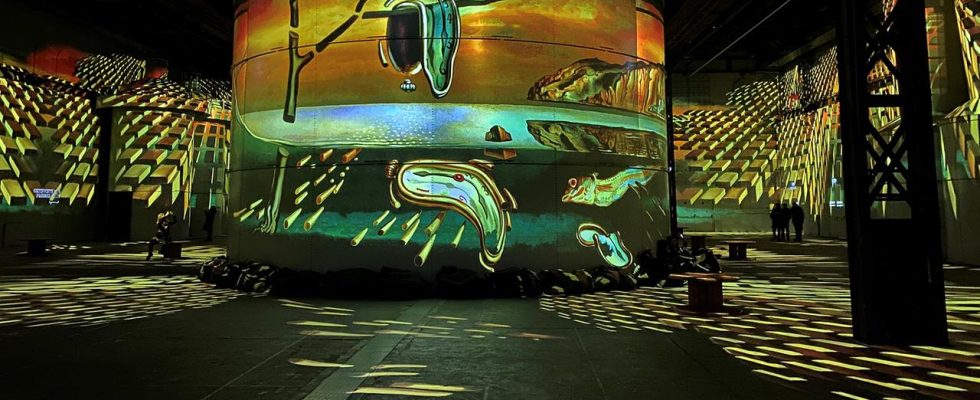Whether Monet, Kahlo or Dalí – more and more exhibitions are using projectors to project images of well-known artists onto huge surfaces on the wall and floor so that viewers can immerse themselves in the work. Is that still art?
Salvador Dalí’s flowing clocks, larger than life, melt onto the 13 meter high walls. Naked men on bicycles cycle along the wall. Black and white photos of the artist on the floor. In the exhibition “Dalí: The Endless Puzzle” a hundred projectors project the works of the Spanish artist into the rooms of an old pudding and rolling mill. The music of Pink Floyd plays from the speakers.
For a year now, the old industrial building in Dortmund has been the center for digital art “Phoenix des Lumières” and shows such immersive exhibitions. Immersive – that means the visitors immerse themselves, are in the middle of the projection.
“The great thing is that Dalí is brought to life here,” says Andreas Gröhbühl. He is sitting on the floor with some other visitors. “It’s just a different quality.”
The colorful images also flash across Christina Göbel’s face. “I wouldn’t necessarily go to a classic museum, for example,” she says. “But it’s really a really great show, a really great atmosphere.”
Making culture more accessible – for 16 euros
But is this still art or pure entertainment? More than half a million people visited the private museum run by the French company Culturespaces last year. According to their own statements, they do not receive any funding. Their goal: to make culture accessible to everyone. The visitor to Dortmund pays 16 euros for the regular ticket.
“It’s not more than 20 or 25 percent of the population who go to museums and know art,” says Bruno Monnier, founder and president of Culturespaces. “With this type of exhibition we can achieve up to 50 percent. Many people who come discover art here and have their first contact.”
Black and white photos of Salvador Dalí are also part of the immersive exhibition “Dalí: The Endless Puzzle” in Dortmund.
“Nothing to do with art”
Mischa Kuball also plays with projections and makes art come alive, but he creates it himself. For example, with his installation “Five Planets,” which can be seen in the Folkwang Museum in Essen. Five spinning disco balls reflect light letters from spotlights throughout the room. They dance across walls and floors and anyone who looks at them for a long time will quickly feel a little dizzy.
The projections of the works of well-known artists have nothing to do with art, says the conceptual artist and professor of public space at the Academy of Media Arts in Cologne. “It’s an addition, something has been added – and that’s why I have great curiosity on the one hand, but also a critical distance,” says Kuball.
Concept artist Mischa Kuball creates projections himself.
“It’s a spectacle for me, but the world needs this.” Kuball believes that people need different ways to come together. “I’m a football fan and I know what kind of energy it produces. I would like to see more communication and also a better critical classification.”
He also lacked different perspectives on art. “The new, large, spectacular rooms are needed in order to sensitize oneself to a chamber concert and a quiet format,” says Kuball. “One goes with the other, but just one would be too one-dimensional for the so-called digital natives.” In the end, projection is first and foremost a technology, art actually created for the screen by the well-known artists themselves.
“Incredibly great fascination”
“It is actually this moment to feel that the artist worked right here, created the picture, and now I am just as close to it as the artist,” says the director of the Museum Folkwang, Peter Gorschlüter, emphasizing the power of the original factory. “And of course you can see the surfaces, the feel, the brush strokes.” It is an invitation to slip into the artist’s mind and see the picture as he or she saw it.
The new exhibitions with the large projections would not bring a new audience to the Folkwang Museum in Essen. “But what we can determine is that immersing yourself in art, being absorbed in art, has an incredibly great fascination for people,” says Gorschlüter. The museum shows original versions designed specifically for rooms as immersive works.
“With this type of exhibition we can achieve up to 50 percent,” says Bruno Monnier, founder and president of Culturespaces.
Opportunity for museums?
In addition to Dalí, works by Gaudí are also shown in the Dortmund rolling mill. The technology is an opportunity for museums all over the world. “Special exhibitions of classical works are becoming increasingly expensive and complicated for museums,” says Culturspaces founder Bruno Monnier. “The works have to be transported. That’s not good for our planet either.”
The natural evolution will be to turn to a different form of exhibition, said Monnier. “Digital can help museums by enabling immersive exhibitions and thus rounding off their offerings.”

